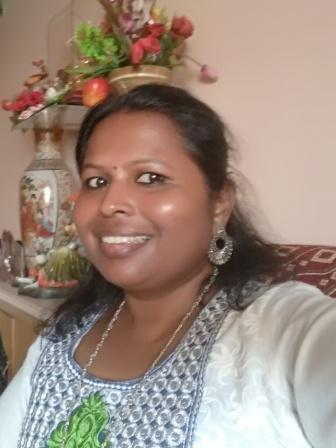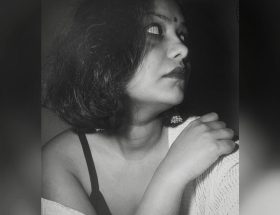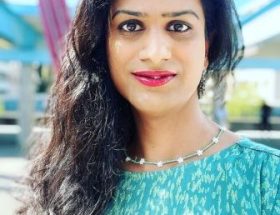Sheetal Kamble
 (The text of her speech ‘Ambedkarite Movement after Dr. Babashaeb Ambedkar and the contribution of Dalit-Bahujan Women’ at IIT Mumbai. It was the Second Lecture in ‘The Savitribai Phule – Fatima Sheikh Lecture Series’ and was organized by Ambedkarite Students Collective, IIT Mumbai on 18th April, 2019.)
(The text of her speech ‘Ambedkarite Movement after Dr. Babashaeb Ambedkar and the contribution of Dalit-Bahujan Women’ at IIT Mumbai. It was the Second Lecture in ‘The Savitribai Phule – Fatima Sheikh Lecture Series’ and was organized by Ambedkarite Students Collective, IIT Mumbai on 18th April, 2019.)
I would like to thank the Ambedkarite Students Collective (ASC), IIT Mumbai for inviting me to talk for the Savitribai Phule-Fatima Shaikh Lecture Series. Today’s topic is Dalit Bahujan women’s contribution in the Ambedkarite movement after Dr. Ambedkar. It is an honor for me to be on the same panel as Mr J. V. Pawar (Founder member of the Dalit Panther).
Before getting to know the contribution of Dalit Bahujan women in the Ambedkarite movement, we must understand who they are and what they have been doing in the Indian village. The Dalit women or former untouchable women have a long history of resistance in the village. In Maharashtra, the Dalit women’s literature is scattered in magazines, newspaper articles, essays, and books. A number of Dalit women’s autobiographies written and published in Marathi language have been later on translated into English.
Historical events give us an idea about their political consciousness and contribution in the anti-caste struggle. The 1927 Mahad Satyagraha was for the natural right to water. Then in 1942, Scheduled Caste Women’s Federation (SCWF) had its first major meeting to empower women to participate in the anti-caste struggle.
Let us talk about the Dalit and Bahujan women activists. Shantabai Dani was the best known woman leader of the Ambedkarite movement. In 1946, she led a protest against the Poona Pact of 1932. She was a member of the Maharashtra State Legislative Assembly from 1968 to 1974. Mukta Sarvagod wrote the book ‘Closed Doors’. In this book, she had written about the life experience of the Dalit community. She was influenced by Savitribai Phule and Dr. Ambedkar. According to her, inequality has been the major source of her humiliation. Her book was dedicated to Baba Amte for having chosen a different and difficult path of serving humanity. Shantabai Kamble’s ‘The Kaleidoscope: Story of My Life’ (1988) was another milestone in Dalit Women’s Literature. She was the first Dalit teacher in Solapur district. Her son Arun Kamble went on to become a well-established writer and a member of the Dalit Panthers.
‘The Prisons We Broke’, the famous book by Babytai Kamble, made the impactful statement that Dalit women don’t have a separate ‘Sanghatan’ (organization and platform). Kumud Pawde was a professor of Sanskrit. She had written the book ‘Outburst’. She also wrote on the women’s movement in Maharashtra. She was the President of the All India Progressive Women’s Organization, which was established in Nagpur in 1974. Urmila Pawar was employed in the State Government Public Works Department. She was also actively involved with the work of autonomous Dalit Feminist organizations in Mumbai and Konkan region of Maharashtra. She wrote about the experience of caste in the village in the book ‘The Weave of Bamboo’ in 2003. Janabai Girhe was one of the first female teachers from Bahujan castes. She had written the book ‘Deadly Pain’ regarding the external and internal pain of the nomadic tribes. Vimaltai More is a Bahujan woman who wrote the book ‘Heart of Three Stones’. In this book she says, “I grew up suffering injustice, helplessness, and humiliation”. These books are not only autobiographies but are also testimonials, which narrated the struggles of Dalit and Bahujan women against caste.
I am not considering today’s speech as an academic speech. It’s the reflection of my work on Dalit women. In 2008, I read Babytai Kamble’s book, ‘The Prisons We Broke’. Such books gave me an insight about Dalit women’s life. When I was reading this book, I tried to connect the memories of my grandmother. She had also gone through the same experiences of caste in the village. Her survival mechanism was very powerful and challenged the caste-based society. She explained the different realities of the village which are not recognized in any way in India, with the honorable exception of Dr. Ambedkar’s writings. Her narratives provided a powerful insight to understand the life of Dalit women.
I met Babytai Kamble in Satara. It was an informal meeting. I asked her about the caste struggle in the village. I asked about the journey of the political and anti-caste movement. She proudly said, “I am a product of the Ambedkarite Movement”. That was an impactful statement for me. She went on to say, “Babasaheb is the light in my life. He had given me not only a conscious understanding of caste but also a voice to speak about Dalit women”. She had recognized that caste is the major source of exploitation not only for the Dalit community but also of the Dalit women. As the discussion went on, she expressed her critical views about the Dalit movement, Dalit politics, religion, and its intellectual state. She said, “Nowadays, every activist and leader wants to prove himself as another Ambedkar”. This was another of her political statements.
She also talked about her memories of hunger, superstition in the community, and some caste based practices. After that, I attended a speech of Urmila Pawar who is well-educated. She was one of the first Dalit women to publicly talk about Dalit patriarchy. Before that, I had never heard about ‘Dalit patriarchy’. But now academically mainstream feminist women articulate about Dalit patriarchy. Then I read the book “We Also Made History” written by Urmila Pawar and Minakshi Moon. Moon passed way in 2004. This book is the eyewitness account of two phenomena – self-expression of Dalit women, and the participation of Dalit women in the anti-caste struggle. This is a unique contribution to the books that gave voice to the Dalit women. Both authors had gathered all the literature and interviewed Dalit women and highlighted the issues of Dalit women in Indian society.
But what happened after Dr. Ambedkar is the crucial question for us. I realized that Dalit women are invisible in the whole Dalit movement. There are few autobiographies, and literary writings available in Maharashtra.
In the 1970s in Maharashtra, a different leadership emerged. Shiv Sena and Dalit Panthers were there. 1975 was a significant period for Maharashtra, in which the feminist movement also emerged. They were talking about gender equality. The first time this movement highlighted gender based violence. They put the agenda of gender equality in the mainstream work against oppression. But Dalit women struggle not only for equality but also for dignity and respect.
Last month, I met Bhanwari Devi from Rajasthan. Bhanwari Devi as a Bahujan woman went through a horrible judgment in the Jaipur High Court. It did not recognize the workplace related violence as well as the Bahujan women’s vulnerability at the workplaces. When I read that judgment on the sexual harassment at workplace, I started to think–is it a mix of gender and caste-based violence or only gender based violence? Because mainstream feminists raised the issue of only gender based violence.
Many times the Dalit women’s issues have been compared to that of Black women. I have tremendous respect for the feminist movement and the Black women’s movements. Black women have their own organization, literature, and theories. They are talking about race, gender, and class and intersectionality. I have doubts and questions about intersectionality. When caste is the base of Indian society, all the oppression of women is based in caste. So we need to work on this intersectionality of the Dalit women. Therefore, Babasaheb clearly stated that Woman is the gateway of the Caste System. I think we need to think more about it. It was the Black women who invented the term ‘safe spaces’ and later on it was picked up by the mainstream feminist movement. It is also because the issues of race and class are deeply intertwined. However, Dalit women are talking about ‘spaces for survival’ because of the threats to life and livelihood in rural and urban spaces. These different kinds of sufferings need to be analyzed.
As a Dalit woman researcher, I did work in rural areas. It was mostly with Dalit women who are survivors of caste-based violence. We need to draw attention towards the narratives of the Dalit women. “I am suffering because of caste; caste is a matter for me”. Such statements from Dalit survivor women echo and become a collective voice taking the standpoint of the Dalit women.
For the representation of Dalit women, we need a Dalit Women’s Sanghatan. That kind of idea is not acceptable in Dalit movement. Politics is supposed to be the domain of Dalit men. Dalit women don’t have space in Dalit movement and the mainstream feminist movement either. But I am not blaming mainstream and Dalit movements. I think this is the responsibility of the Dalit community and Dalit women. They should come forward and raise their voices in public spaces and the Dalit community should support them.
Thank You.
~~~
Sheetal Kamble is a research scholar in Tata Insititute of Social Sciences (TISS). Her research topic is ‘Caste based violence Against Women Case Studies of Dalit Women of Rural Maharashtra’. She had done her M. Phil earlier from the same institution. She presented papers at various conferences, and her papers have been published in reputed journals. She had worked with SAHELI, Special Cell for Women and Children (Government of Maharashtra) and Training of the Trainers programme of University student skill Development (NUSSD).










